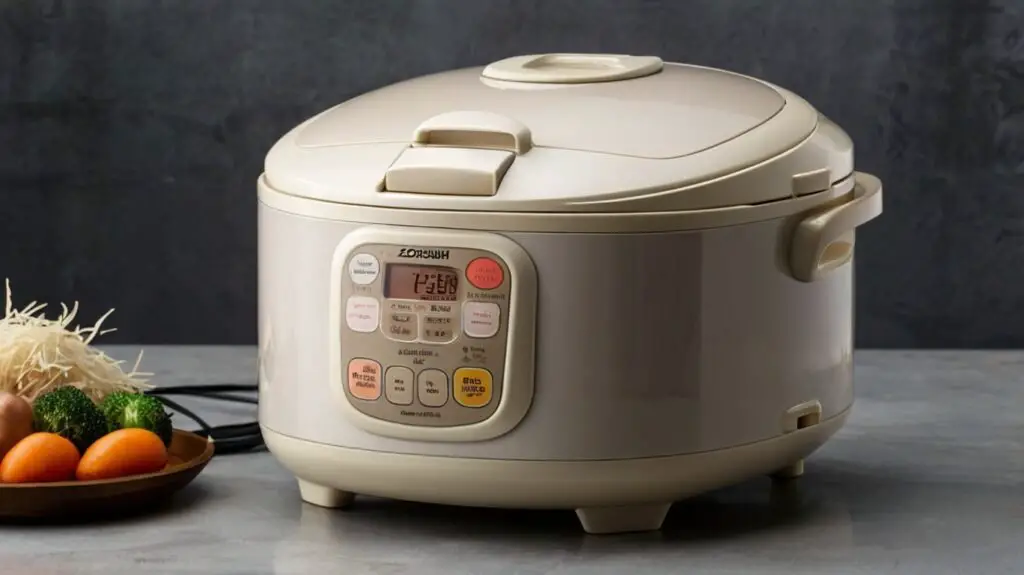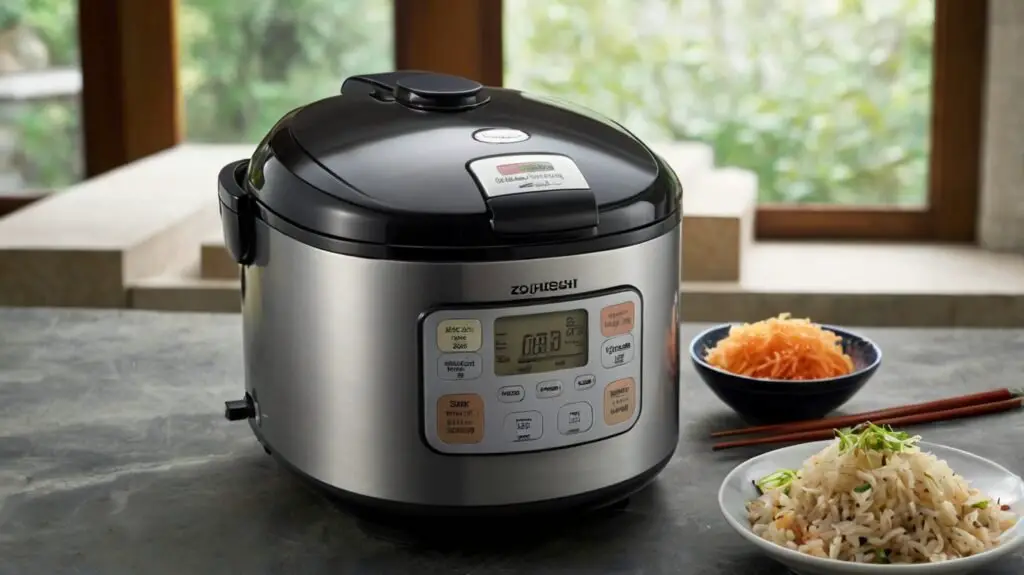I remember my first encounter with a Zojirushi rice cooker it was love at first sight! But as I learned more about these products, I discovered that not all Zojirushi items are created equal. The country of manufacture can have a significant impact on quality and functionality. So, let’s dive into this fascinating comparison of Zojirushi made in Japan versus China!
Top Rated Zojirushi Made in Japan And China:
- Zojirushi NS-ZCC10 5-1/2-Cup Neuro Fuzzy Rice Cooker- Made In Japan
- Zojirushi NW-JEC10BA Pressure Induction Heating Rice Cooker- Made In Japan
- Zojirushi NP-HCC10XH Induction Heating System Rice Cooker- Made In Japan
- Zojirushi NS-TSC10 5-1/2-Cup (Uncooked) Micom Rice Cooker- Made In China
- Zojirushi NL-BAC05SB Micom Rice Cooker & Warmer- Made In China
1. The Zojirushi Brand: A Brief History
The Zojirushi brand is more than just a name in kitchen appliances. Founded in Japan in 1918, Zojirushi has carved out a niche that combines innovation with quality. What do you think makes a brand standout? For Zojirushi, it’s their mission: blending tradition with modern technology.
Legacy of Quality
Throughout the years, Zojirushi has built a legacy rooted in a commitment to quality. They started with humble products. Their original lineup featured vacuum bottles, rice cookers, and bread makers. Imagine having a rice cooker that not only cooks rice perfectly but also lasts a long time! That’s the Zojirushi promise.
As times changed, so did their manufacturing locations, yet their dedication to excellence remained unchanged. It’s inspiring to see a company keep its core values while adapting to the world around it.
Innovation is Key
- Founded: 1918
- Known for: Innovation in high-quality kitchen appliances
What really sets Zojirushi apart is their approach to innovation. This sentiment captures the essence of what Zojirushi strives for, enhancing everyday cooking experiences.
Chart Overview
| Year Founded | Original Products |
|---|---|
| 1918 | Vacuum bottles, rice cookers, bread makers |
In summary, Zojirushi’s history is not just about dates and products. It’s about a passion for quality and a determination to innovate. As they continue to evolve in the kitchen appliance market, their commitment to excellence shines through. And who wouldn’t want a piece of that tradition in their kitchen?

2. Japanese vs Chinese Manufacturing: What’s the Difference?
Let’s talk about how Japanese and Chinese manufacturing differ. You might think they are similar because they both produce goods for the global market. However, when we dig deeper, we see some major contrasts, especially in materials, quality control, and design.
Materials Used in Manufacturing
The materials used in Japanese manufacturing often emphasize quality and sustainability. Contrastingly, in China, the focus can lean more towards cost-effectiveness. This difference shapes the final product significantly. Are you more inclined toward quality or cost?
Quality Control Processes
Quality control is another area where Japan sets itself apart. Japanese manufacturers prioritize precision. They implement strict processes to ensure every product meets a high standard. On the other hand, Chinese operations may prioritize speed and volume, which can sometimes compromise quality.
Influence of Product Design
Have you ever noticed how different appliances look? This is influenced heavily by where they are made. Japanese designs often integrate functionality with aesthetics, while Chinese designs can emphasize modernity and cost-saving features.
| Country | Quality Rating |
|---|---|
| Japan | 9/10 |
| China | 7/10 |
An overview of how and where a product is made can affect its longevity and efficiency. Quality ratings often reflect these manufacturing differences. So, the next time you purchase an appliance, think about where it was made and the implications of that choice.
3. Performance Comparison: Functionality of Products
When comparing products, performance is key. Let’s talk about two significant players in the rice cooker market: Japanese and Chinese models. I’ve had quite the journey with both, and I want to share my insights with you.
High-End Features in Japanese Models
First up, the Japanese models, particularly from brands like Zojirushi. These rice cookers boast high-end features that make cooking a breeze. For instance:
- Advanced temperature control
- Multiple cooking settings for different rice types
- Durability and design that lasts
The cooking time averages around 30 minutes, producing fluffy and aromatic rice.
Budget-Friendly Options in Chinese Models
On the other hand, Chinese rice cookers provide budget-friendly options that don’t skimp on functionality. They usually cost less, making them attractive for those who are price-conscious. While the average cooking time is about 40 minutes, you might find:
- Simple cooking functions
- Compact designs
- Great value for everyday use
These cookers might not have all the bells and whistles, but they still get the job done!
My Personal Experience
I’ve used both. The Japanese model won me over with its consistent results and advanced features. But the Chinese models surprised me too; they’re perfect for someone who wants an easier, no-fuss approach without breaking the bank.
In the end, it all depends on what you value in a rice cooker. While I enjoy the rich features of high-end Japanese models, there’s something to say about the practicality of Chinese models. Each has its own strengths that cater to different needs.
4. Price Point: Is It Worth It?
When it comes to purchasing culinary appliances, we often think about two critical factors: price and quality. The price point for products varies greatly. Let’s explore these differences.
Price Range for Japanese Products
Japanese products generally fall into the higher price bracket. If you’re considering something like a Zojirushi rice cooker, you’re likely looking at an average price of around $200. This is a significant investment for many of us. However, I believe that quality often justifies the cost.
Cost-Effective Choices from China
On the other hand, we have products manufactured in China. The average cost of these items is about $120. You can find some surprisingly good options that don’t compromise on quality.
- Innovative designs
- Decent durability
- Standard performance
So, can we really get a bang for our buck with these products? Often yes, but it depends on the intended use.
My Perspective on Value for Money
I often hear friends wonder, “Is spending more really worth it? Investing in a higher-quality product can lead to better performance and longevity.
In summary, understanding the balance between price and quality is vital. We want value, but also a reliable product that meets our culinary needs, right? It’s all about making informed choices.
5. Consumer Opinions: What Are Buyers Saying?
When it comes to products like Zojirushi cookers, opinions vary greatly depending on where you are in the world. In Japan, the average user rating is an impressive 4.8 out of 5. Meanwhile, in China, it’s still great but lower, sitting at 4.0 out of 5. Why this discrepancy?
Reviews: A Mixed Bag
Consumer reviews often reflect local preferences. In Japan, Zojirushi is celebrated for its quality and longevity. Users often rave about their Japanese Zojirushi cookers!
It’s common to see glowing feedback highlighting ease of use and efficiency.
In contrast, reviews from China can reveal mixed feelings. Some users appreciate the features, while others note issues with durability. What does this mean for buyers? It suggests that location plays a role in how a product is perceived.
Social Media Feedback
- Social media platforms buzz with personal stories from users. Many share their experiences and highlight their favorite features.
- Review websites also provide insights, showing how consumer sentiment sways potential buyers.
Ultimately, the way consumers talk about these products can impact your buying decisions. Personal anecdotes from friends often prove invaluable, too. Have you ever bought something based on a friend’s recommendation? I know I have.
Trends in Consumer Sentiment
Exploring review trends shows how important it is to stay connected. A simple tweet or Instagram post can change a brand’s image overnight. This highlights the power of feedback, regardless of its origin. So, before buying a Zojirushi cooker, consider not just the ratings, but also the conversations happening around them.

6. FAQs About Zojirushi Products
If you’re considering purchasing a Zojirushi product, you likely have some questions. Don’t worry, you’re not alone. Let’s dive into some of the most frequently asked questions about these popular appliances.
Where are Zojirushi Products Made?
Many people are curious about the origin of Zojirushi products. Most are made in Japan. This is significant. Why? Japanese craftsmanship is often praised for its precision and quality. That said, Zojirushi also manufactures some models in China, which may lead you to wonder about quality differences.
Are Japanese Zojirushi Products Really Better?
This is a hot topic among fans. Japanese models typically feature advanced technology and robust quality control. However, the Chinese models also maintain high standards. It really depends on the model and your specific needs. What are you looking for in a product?
Can I Get Parts for Older Models?
Yes, you can! Zojirushi offers replacement parts for many older models. It’s a good move to contact their customer support team. They can assist you in finding the right parts. This can save you money in the long run.
How to Choose the Right Model for My Needs?
Choosing the right Zojirushi model can feel overwhelming. Start by identifying your main needs. Do you want a vacuum-insulated bottle for hot drinks? Or a rice cooker that ensures perfect rice every time? Think about your lifestyle. What fits best?
We recommend making a list of features that matter most to you. Comparing different models online can also be helpful. The right choice will ultimately depend on how you plan to use it.
Addressing these common questions can truly help potential buyers make informed decisions. Zojirushi provides quality and customer support, ensuring that you are supported throughout your buying journey.
Conclusion: Making an Informed Decision
The journey to finding the right product isn’t just about picking a brand at random. It’s about knowing where your product comes from. Understanding the origins of a product can make a significant difference in quality and performance. For instance, some brands are known for certain manufacturing practices that might align with your values or specific needs. When considering purchases, I always remind myself that knowledge is power when it comes to purchasing! – Consumer Advocate.
So, what’s my ultimate recommendation for buyers? Look beyond just the price tag. Consider the craftsmanship, materials, and the reputation of the brand. It’s essential to weigh the value of quality against affordability. Sometimes, investing a bit more upfront leads to less hassle and better satisfaction in the long run. Think about products that last. They save you money over time.
Also, research your personal needs. Are you after a product for everyday use, or do you want something special? Knowing what you truly need will guide you to the right choice. Just because something is trendy doesn’t mean it’s right for you.
In conclusion, as consumers, we must grasp the importance of being well-informed. The relationship between brand loyalty and product longevity plays a crucial role in our purchasing decisions. Ultimately, take your time to analyze, compare, and reflect. These steps will help ensure that you make wise choices for your lifestyle.
TL;DR: Zojirushi products vary greatly depending on their origin. Japanese products tend to offer superior quality and features, while Chinese options are often more budget-friendly. Knowing the differences can help you make an informed purchase.
